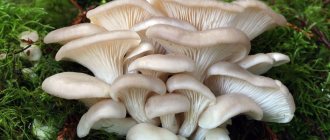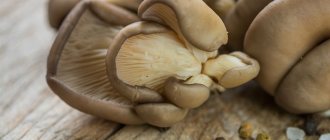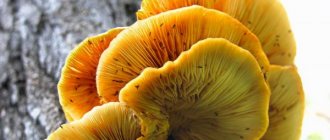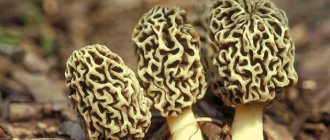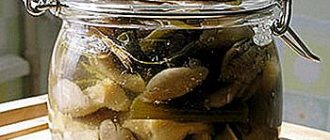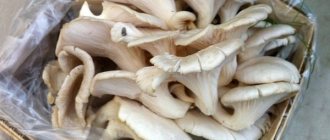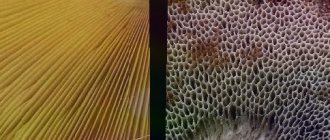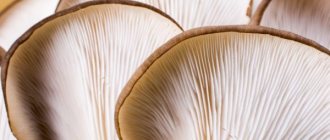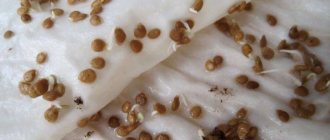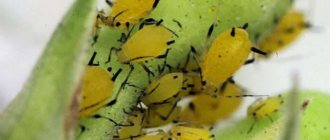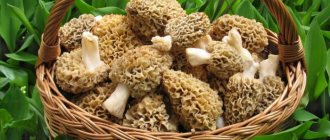Description
The cap of the oyster mushroom is fleshy. At first it is convex and then becomes smooth. In mature specimens, it has the shape of a shell (in Latin ostreatus - oyster) like an oyster.
The surface of the mushroom caps is smooth and shiny, wavy. At the beginning of growth, the cap is indistinguishable from the stem. It then takes on an oyster shape and then changes to a spatula or fan shape once the mushroom reaches maturity. A recess is formed at the top.
The most common oyster mushrooms
The most common types of oyster mushrooms include:
- Pulmonary . The diameter of the cap reaches 15 cm. The color is light gray in the young fruit body and yellowish in the old one. Fan shape. The stem is short and matches the color of the cap. The mushrooms are meaty and have a pleasant aroma. This species is edible and very tasty. They usually grow on deciduous trees in forests or park areas. They bear fruit from July to September.
- Royal . This is a delicious type of these mushrooms, hence the name. The cap is small in size - 4–13 cm. Young mushrooms are white with a red or gray tint, and old ones become yellow. The leg is small - up to 4 cm. The plates are not densely located. The pulp is dense and fleshy. The taste is light with pleasant mushroom notes. Such oyster mushrooms grow in the steppe zone, which distinguishes them from all other species. They bear fruit in the first half of autumn.
- Autumn . The hat (length about 12 cm, width - 6 cm) looks like the shape of an ear. The color is gray and darkens as the mushroom grows. The pulp is white and aromatic. The plates are also white. The leg is short, dense and slightly drooping. You can see such mushrooms on stumps and deciduous trees. They usually live in mixed forests. They bear fruit from August to December. Edible mushrooms.
- Horn-shaped . The mature cap of the fruiting body has a horn-shaped shape measuring 4–13 cm. The color is white or yellow, but as it ripens it becomes brown. The leg is very short, about 1 cm long. It comes in a milky or gray shade. The plates are light and sparsely located. The pulp is fleshy, aromatic and tight. They prefer to grow on aspens, birches, oaks, rowan trees or maples. They bear fruit from May to September.
- Oak . The cap has a convex semicircular or oval shape with wavy edges, up to 10 cm in size. In a mature mushroom, it becomes concave. The color is cream or yellow. The leg is short and cylindrical. The plates are densely located. Their color matches the color of the cap. The pulp has a light sweetish aroma, but is hard and dense. This type of oyster mushroom grows on deciduous trees in temperate climates. Fruits in the second half of summer and early autumn.
Mushroom color options
The color of the oyster mushroom cap varies from dark gray with purple hues to the color of light and even dark hazelnut.
Purple oyster mushrooms
The tone that the mushroom takes is brownish-dark, brownish-reddish, from black-violet to blue-blue at the final stage of fruit development. Before dying, the mushroom turns pale and white.
Gray oyster mushrooms
The leg is developed and short. Due to its irregular cylindrical shape, the mushroom appears squat.
Appearance of autumn oyster mushroom.
Autumn oyster mushroom is a lamellar mushroom, popularly called pig mushroom.
The autumn-type oyster mushroom has a short leg with a rather curved shape. The mushroom has a color of more saturated shades, located unevenly. The surface of the cap has a smooth structure.
A characteristic feature of autumn oyster mushroom is the fusion of legs. Upon external examination, you can see that several mushrooms fit tightly together. This figure is very reminiscent of a petal.
Oyster mushroom habitat
Oyster mushroom is a saprophytic fungus and only occasionally a parasitic fungus. Attaches to the stumps of poplars and mulberries. Oyster mushrooms develop in small groups, very close to each other. Often the mushroom caps overlap one another, like tiles on a roof.
These mushrooms develop on trunks even at a considerable height from the ground. They grow on broad-leaved and rarely coniferous trees. Oyster mushrooms are also common in city parks and on the edges of roads and highways. This mushroom grows from plains to mountains and there are no difficulties with growing oyster mushrooms.
Oyster mushroom is widespread in many temperate and subtropical forests around the world; the mushroom does not grow in the Pacific Northwest of North America. It is a saprophyte that in nature decomposes dead wood, especially in deciduous and beech plantings.
Oyster mushroom is also one of the few known carnivorous mushrooms. Its mycelium kills and digests nematodes, which biologists believe is the fungus's way of obtaining nitrogen.
Oyster mushrooms grow in many places, but some species develop colonies only on trees.
This fungus most often grows on dying deciduous trees; it acts on them only saprophytically, and not parasitically. As the tree dies from other causes, oyster mushrooms receive a rapidly growing mass of already dead and dying wood to grow. Oyster mushrooms actually benefit the forest by breaking down dead wood and returning vital elements and minerals to the ecosystem in a form that can be used by other plants and organisms.
When and where do oyster mushrooms grow?
Oyster mushrooms settle in groups on deciduous trees: birch, oak, aspen, etc. They can also be seen on fallen branches, trunks and stumps. Less common on coniferous trees. Often these mushrooms are grown at home in a special substrate, which consists of plant waste.
They bear fruit intensively from May to September, but oyster mushrooms can be collected in the wild until November. In winter, the growth of mushrooms stops, after which their condition largely depends on the time of frost and the stage of development at that moment. If the fruiting bodies managed to ripen before the onset of low temperatures, then in winter they can continue to hang in the place where they grew.
Did you know? Oyster mushrooms are predators that are able to feed and digest various worms. Thanks to this, it is almost impossible to find wormy mushrooms.
In this state, the mushrooms are semi-solid and can be cut off. If the frost was preceded by rainy weather, then it will not be possible to cut the oyster mushrooms from the tree, since they will be very hard. To get a group of fruiting bodies, they must be knocked down.
Growing oyster mushrooms at home
For growing mushrooms, stores sell boxes/bags with substrate and oyster mushroom spores, and they are convenient to grow at home.
Growing mushrooms brings great satisfaction and is beneficial for the family budget. There are two ways to grow this and other mushrooms. The first method is “manual” cultivation on the ground in a garden or greenhouse. The second, recommended one, is “industrial” cultivation using substrates (bales) already prepared by enterprises for use at home.
Growing oyster mushrooms manually “on the ground”
During the cold season, trunks are cut, possibly from poplar, with a diameter of more than 20 cm. The winter period is important because the tree must stop growing. Once trimmed, the stumps are stored upright in a shady area to await use, which usually occurs between April and June.
30 cm segments are cut from the trunks, holes are dug 1 meter wide and 120 cm deep. A layer of mushroom mycelium is placed at the bottom of the pit, and vertically located trunks are placed on top. Then another layer of mycelium and a trunk, and so on. The upper part is covered with boards and a 15 cm layer of soil is poured.
The heat and humidity that forms inside the pit will facilitate the distribution of mycelium over the logs laid inside. In September, the trunks are removed and buried one by 15 cm, at a distance of 30 cm from each other. In about twenty days, oyster mushrooms will begin to grow, which is repeated in each subsequent season.
Growing oyster mushrooms on an industrial substrate in bags
This is a growing method that everyone can comfortably use right in the home without the need to dig the ground or have free space in the yard.
In this case, they do not use chopped trunks, but bags with a substrate consisting of straw from corn, wheat and legumes. This compound is inseminated with mycelium cultures and then placed in a plastic container.
The bale made in this way is ready for incubation, this period lasts about 20 days and takes place in a place with a temperature of about 25°C. As soon as the mycelium has penetrated the entire bag of substrate, remove the plastic and place the bag on a shelf in a sunny or artificially lit place and maintain the temperature at about 15°C.
Oyster mushrooms grow in cycles in bags of substrate. The growth period is artificially interrupted by lowering the room temperature.
3 ways to grow oyster mushrooms - video
What do oyster mushrooms taste like?
Cooked oyster mushrooms have a smooth, oyster-like texture, and some people report a slight seafood flavor. Gourmets believe that oyster mushrooms have a subtle anise aroma.
Both flavors are subtle and generally undetectable once mushrooms are added to a main dish. In general, oyster mushrooms have a mild flavor with a slight earthy undertone.
How to distinguish false forest oyster mushrooms
To distinguish inedible oyster mushrooms, you need to thoroughly study the ordinary or oyster representatives. They are edible and prized for their low calorie content.
How to identify true oyster mushroom:
- The cap is soft, round, and resembles an oyster. On the outside it is glossy, smooth, and sometimes fibrous. The color is gray, sometimes with shades of purple, brown, cream, and yellow. The size of the cap can reach 25 cm in diameter.
- The stem is short, widening towards the cap. Has a cream color. Towards the base it becomes hard and fleecy.
- The pulp is juicy and soft; as it ages, it becomes tougher due to the appearance of new fibers.
Real oyster mushroom is popular. There are a lot of cooking options. It can be stewed, dried, canned, fried, pickled, frozen. It is widespread in the countries of the former Soviet Union. It prefers low temperatures, so it begins to grow in the fall. In summer it appears in cold weather.
Important! Edible oyster mushroom is used in medicine. It is used to make medicines that are used in the treatment of oncology and during chemotherapy.
Photos and descriptions will help you recognize false oyster mushrooms:
- Brighter color.
- Lack of legs, hat fastening (not for all).
- No characteristic mushroom smell.
- Very bitter taste.
- The fusion of caps and legs, the formation of a single “organism”.
In Russia, oyster mushroom lookalikes are less common than ordinary ones. They are not poisonous, but are not popular. Experienced mushroom pickers do not pay attention to them.
Oyster mushroom recipes
The gastronomic interest in mushrooms is due to two factors. First of all, it is good edibility. Secondly, oyster mushrooms are easy to grow.
Oyster mushrooms are prepared in various ways. Baked, breaded and fried mushrooms are quite common in many cuisines around the world. As a rule, oyster mushrooms are grilled, breaded with butter or stewed. They also taste excellent when preserved in oil.
Cooks recommend throwing away the leg because it is not very tender and is too hard. Oyster mushrooms are cleaned and chopped, like all other types of mushrooms.
Fried oyster mushrooms
Oyster mushrooms are great for cooking in a pan with or without other ingredients. They are also perfectly breaded, as if they were cutlets, especially if they are soft young specimens.
Oyster mushrooms in seasoning
After boiling briefly for a few minutes, the mushrooms are eaten seasoned with oil, lemon, salt and pepper.
Stuffed oyster mushrooms
After a few minutes of pre-cooking, the mushrooms are poured with mayonnaise and seasoned with parsley and finely chopped green onions. To boil oyster mushrooms for this recipe, add vinegar and salt and pepper to the water. Professional chefs recommend using young specimens.
Oyster mushrooms in oil
Oyster mushrooms, when placed in oil or vinegar, retain their meatiness. Thanks to this property, oyster mushrooms are suitable for fillings, rice salads and other recipes.
Dried oyster mushrooms
These mushrooms are also suitable for drying and chopping. In this case, it is advisable to add mushroom powders that are more aromatic than oyster mushrooms to the mixture.
Inedible species
As with any mushrooms, you need to be careful with oyster mushrooms. types of inedible oyster mushrooms in this family
Oyster mushroom sheathed or covered. One of the few species of this family that are inedible mushrooms. The flesh is hard and rubbery and smells like raw potatoes. The fetal cap begins to develop like a bud. Gradually opening up, it covers the tree, taking on the shape of a tree. The surface remains convex with turned edges. The top of the fruit is smooth and slightly sticky with moist stripes radiating from the center to the edges. The color is light gray-brown, in dry weather it gives off a steely sheen. Unlike its edible relatives, it becomes darker with age. There are practically no legs. They grow alone. The main distribution area is Northern Europe. The fruits ripen in the first part of summer.- Orange oyster mushroom, genus Phyllotopsis. Strictly speaking, this is a mushroom of a different family, but because of its appearance and method of growth, people believe that this is a false oyster mushroom. It is impossible to get poisoned by them, but such mushrooms are not suitable for eating due to the lack of taste. However, due to its beauty, it is grown in gardens. The bright orange fruit will delight you even in winter; it looks especially beautiful against a snow-white background.
- Wolf sawfolium from the Auriscalpiaceae family . A young family resembles an oyster mushroom. The cap is from 3 to 6 cm. The leg is no more than 1 cm. The surface color is whitish-brownish, sometimes yellowish red, slightly matte and velvety. The plates are frequent and wide with a jagged edge and a whitish-beige color. You can’t get poisoned by it, but it’s difficult to get rid of the “causticity” even after cooking for a long time. If such false oyster mushrooms end up in a dish, the taste will deteriorate irrevocably.
Nutritional and medicinal value of oyster mushrooms
For 100 grams of mushrooms there are:
- 38 calories;
- 15-25 g protein;
- 6.5 g carbohydrates;
- 2.2 g fat;
- 2.8 g fiber;
- 0.56 mg thiamine;
- 0.55 mg riboflavin;
- 12.2 mg niacin;
- 140 mg phosphorus;
- 28 mg calcium;
- 1.7 mg iron.
Oyster mushrooms have a wide range of nutritional and medicinal properties. Like most edible mushrooms, they are an excellent source of protein, carbohydrates and fiber, and are low in fat. The mineral composition of mushrooms varies depending on the species and substrates used.
Typically, oyster mushrooms contain the following minerals: Ca, Mg, P, K, Fe, Na, Zn, Mn and Se. They are also a source of vitamins B1 and B2, thiamine, riboflavin, pyridoxine and niacin.
Oyster mushrooms are considered a functional food due to their ability to have positive effects on human health. Some scientific works report antimicrobial and antiviral properties of oyster mushrooms. Their methanol extracts inhibited the growth of Bacillus megaterium, S. aureus, E. coli, Candida glabrata, Candida albicans and Klebsiella pneumoniae.
Ubiquitin, an antiviral protein, is also found in the oyster mushroom fruiting body. In particular, fungi contain ribonucleases that destroy the genetic material of the human immunodeficiency virus (HIV). A similar effect is exerted by the lectin protein isolated from the oyster mushroom fruiting body.
Polysaccharides obtained from oyster mushroom mycelium demonstrate antitumor activity. Doctors observed a 76% reduction in tumor cells when a polysaccharide from a culture broth was administered intraperitoneally to female Swiss albino mice.
Notably, oyster mushroom extracts showed antitumor activity against certain types of lung and cervical sarcomas. The level of antioxidants in the fruiting bodies is also reported to be higher compared to other commercial mushrooms.
Oyster mushrooms also exhibit hypolipidemic and antihyperglycemic properties. Mevinolin lowers cholesterol levels. In addition, oyster mushrooms produce a compound for use in antidiabetic medicine. A study found that oral administration of aqueous extracts of oyster mushrooms in diabetic mice reduced blood glucose levels.
Many species of oyster mushrooms contain bioactive compounds such as glucans, vitamin C and phenol, which enhance the action of certain enzymes that reduce liver cell necrosis. Oyster mushroom extracts are also reported to lower blood pressure, have immunomodulatory activity and anti-aging properties.
Oyster mushrooms promote weight loss. Oyster mushrooms, due to their high protein content and low fat and carbohydrate content, help in weight loss. Therefore, if you are losing weight, be sure to include oyster mushrooms in your diet.
Harm of oyster mushrooms
The beneficial properties of oyster mushrooms are undeniable and numerous. But these mushrooms can also be harmful to humans.
The most obvious sign that the body does not accept oyster mushrooms in large quantities is abdominal pain after a person has eaten too many mushrooms in any form, fried or boiled. There are no other specific contraindications. Intemperance in eating is a sign that the eater has forgotten about the sin of gluttony, and not a side effect of the mushroom. In large quantities, oyster mushrooms provoke bloating, increased gas formation in the intestines, lead to diarrhea and other dyspeptic disorders.
All mushrooms, including oyster mushrooms, take a long time to digest in the gastrointestinal tract. This is good for the body, which extracts more nutrients, but bad for a sensitive stomach. Oyster mushrooms cause pain in the epigastric region in children and the elderly.
Oyster mushrooms are allergenic to sensitive organisms. Therefore, they are used with caution in case of food allergies.
Like any other mushrooms, oyster mushrooms are consumed only after treatment with heat, since the chitin in the raw mushroom is dangerous to humans.
